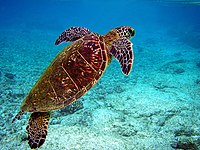
Photo from wikipedia
Abstract. Evidence for sea-level change during and around Marine Isotope Stage (MIS) 5e (ca. 125 ka) in southern Africa derives from a wide variety of geomorphic and sedimentological sea-level indicators, supported in the… Click to show full abstract
Abstract. Evidence for sea-level change during and around Marine Isotope Stage (MIS) 5e (ca. 125 ka) in southern Africa derives from a wide variety of geomorphic and sedimentological sea-level indicators, supported in the past 2 decades by absolute chronological control, particularly on littoral deposits, some of which have a quantifiable relationship to former sea level. In addition to these proxies, data provided by both terrestrial (dune sediments and archaeological remains) and marine (lagoonal and nearshore littoral sediments) limiting points provide broad constraints on sea level. Here, we review publications describing such data points. Using the framework of the World Atlas of Last Interglacial Shorelines, we insert in a standardized database ( https://doi.org/10.5281/zenodo.4459297 , Cooper and Green, 2020) all the elements available to assess former palaeo-relative sea level (palaeo-RSL) and the chronological constraints associated with them (including uncertainties). Overall, we reviewed 71 studies, from which we extracted 39 sea-level indicators and 26 limiting points. As far as age attribution is concerned, early analysis of molluscs and whole-rock beachrock samples using U series allowed dating of several sea-level indicators during the 1980s, but the more widespread application of optically stimulated luminescence (OSL) dating since 2004 has yielded many more (and more accurate) sea-level indicators from several sites. This has helped resolve the nature and timing of MIS 5e shorelines and has the potential to further elucidate the apparent presence of two or more sea-level peaks at several South African sites during this interval. The standardized sea-level database presented in this paper is the first of its kind for this region. Future research should be directed to improve the stratigraphic description of last interglacial shorelines and to obtain better dating, high-accuracy elevation measurements with better palaeo-RSL interpretation.
Journal Title: Earth System Science Data
Year Published: 2021
Link to full text (if available)
Share on Social Media: Sign Up to like & get
recommendations!